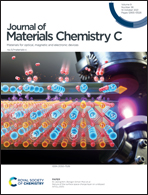Preventing isomerization of the fused-ring core by introducing a methyl group for efficient non-fullerene acceptors†
Abstract
Different cyclization reaction sites on the benzene ring will produce isomers during the cyclization process for the synthesis of small-molecule acceptors. Herein, we developed a structural unit (named BTMe) that can prevent isomerization during cyclization by introducing a methyl into a benzo[b]benzo[4,5]thieno[2,3-d]thiophene (BTBT) unit. Two fused ring electron acceptors (BTMe-C6-2F and BTMe-C8-2F) with the BTMe core were synthesized by changing the length of the side chain. When they were blended with donor PM6, the active layer PM6:BTMe-C8-2F exhibited a more excellent charge transport, phase morphology and π–π stacking, which are beneficial to improve the short-circuit current density (Jsc) and fill factor (FF). Compared with BTMe-C6-2F, the organic solar cell (OSC) based on BTMe-C8-2F exhibited a higher power conversion efficiency (PCE) of 12.72% with a Voc of 0.97 V, a Jsc of 19.65 mA cm−2 and a FF of 66.76%. These results proved that it is a promising approach to achieve a high-performance small-molecule acceptor by changing the length of the side chain and introducing methyl groups to prevent the isomerization of the fused ring core owing to special reaction sites.



 Please wait while we load your content...
Please wait while we load your content...